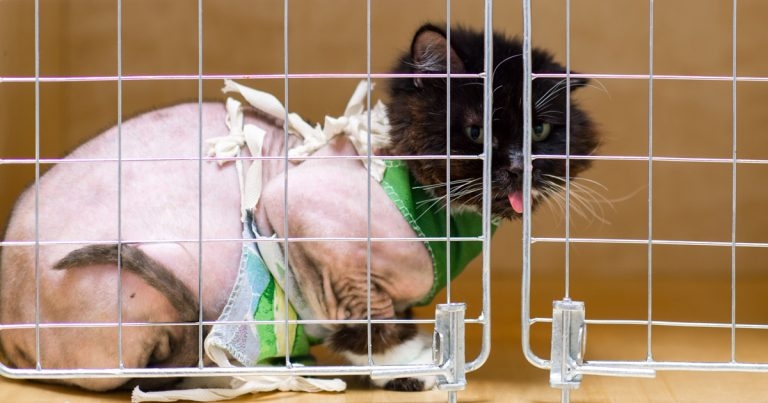4 Apr 2019
Jane Davidson asks whether more should be done to prepare clients for their pet’s hair loss post-surgery – using the example of Ollie the cat, documented on Twitter by her owners Ricky Gervais and Jane Fallon.

Image © benevolente / Adobe Stock
I’m watching Twitter with joy as @myleftfang (Ollie to those who know her) parades her nekkedness on social media. It’s an issue close to my heart, so I thought I’d talk about it with Ollie’s experience as a starting point.
For those wondering, Ollie is Ricky Gervais and Jane Fallon’s cat. She is very active on Twitter, but, recently, hasn’t been very well. Her current nekked state is her nakedness after being shaved for bloods, IVs and ultrasounds.
Like all vet staff, I know we need to shave our patients for infection control and diagnostic reasons, but I still privately grapple with the really sick patients who get balded to within an inch of their life then pass away looking like naked mole-rats.
I know that’s a very unprofessional reaction, and I fight against it so much, but we know fur loss in our patients is an emotional issue for our clients, and something we need to prepare them for.
Planned fur loss is needed for some diagnostics, some treatment pathways and surgery. It can be easy to clip a small patient almost 75% bald once they’ve had fluids, bloods, ultrasound and surgery.
However, while all this is necessary, we do need to prepare our clients for exactly how much fur loss may occur.
As humans, our emotional attachment to our own hair is very complex – and it seems we transfer this to our pets, too.
I’m sure we’ve all been there – we’re super-pleased a patient is doing well after life-saving surgery, yet, when visiting, the client can only focus on how much fur his or her pet has lost.
This can be a little disheartening for us, as we accept the fur loss as part of the bigger picture of keeping a pet alive. But maybe we need to prepare owners for the fur loss before it happens.
I know we usually say “we do need to shave for X, Y and Z”, but the client often doesn’t have a clue what that really means, how big the shaved area will be and how quickly the fur will grow back.
In one instance, a client became rather confused when we placed an IV in her dog’s left front leg to x-ray its right front leg. She thought we had shaved a patch to take the x-ray and had taken a view of the wrong leg (and only of a tiny part of this large dog’s leg). Maybe our level of what we clip hair for needs to be shared?
I once had a client say she wouldn’t be letting her cat out in the garden when he got home, as all the other cats would laugh at him. Well, she was right about the cat not going out (as he was still very unwell, and needed rest and monitoring), but, to her, the biggest issue was the shaved belly.
I felt we had expertly clipped the surgical site so that, with his long hair, you could only see the bald area if you could directly see his belly – obviously, our hairdressing skills weren’t enough.
THEY HAVE SHAVED MA BELLY pic.twitter.com/nVVdtBihO2
— Ollie (@myleftfang) January 17, 2019
As we already often say some fur loss will occur, it may be worth expanding that to roughly describe the size of shaved area, as well as the precautions and care taken to shave the area and keep the patient warm.
It may also help, at some point, to say how long fur takes to grow back and that, after the first two to three weeks, it’s not very noticeable once a small fluffy covering of undercoat returns.
Post-clipping, a few issues may need explaining – the colour of the fur may change, the texture may change, and there is a genuine condition of post-clipping alopecia.
For Siamese-type colour point patients, like Ollie, a temporary colour change may occur. The “points” of darker colour are on the cooler parts of the body, such as ear tips and paws. When body fur is clipped, it lowers the temperature of the skin – and when the first fur grows back, it’s often at the darker colour of the “points”.
However, it’s only temporary – once the first moult occurs, it will go back to the usual colour – I promise, Ollie!
The texture of some patients’ hair may also change temporarily – so, again, it’s worth speaking to owners about potential changes after the fur grows back.
Finally, a risk exists of post-clipping alopecia. This could be due to hormone issues that are already known, but it’s sometimes idiopathic. Its rare but should be discussed, if at all possible.
Luckily, Ollie is now on the mend and the first few dark fluffy patches have started turning blonde again.
Sometimes, directing emotions to the not-so-stressful parts of their pets care is a way for clients to cope, so be prepared for the nekked reactions and be prepared to spend time explaining fur growth when you really want to describe the life-saving surgery you have done.
If a client really is worried about the fur loss, it may be because he or she trusts that for the “big stuff“ he or she can’t see, you were great – so he or she will worry about what they can see.